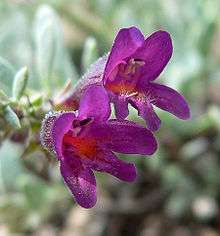Penstemon thompsoniae
Penstemon thompsoniae is a species of penstemon known by the common name Thompson's beardtongue. It is native to the southwestern United States where it grows in woodlands and other desert and plateau habitat, to the subalpine climate of local mountains. It is a mat-forming perennial herb, ashy gray-green with a thick coating of hairs, growing no more than 15 centimeters tall from a woody base. The oval or spoon-shaped leaves are up to 2 centimeters long. The short inflorescence bears wide-mouthed tubular purple flowers up to 2 centimeters in length. They are glandular on the outer surface and somewhat hairy on the inner, the staminode coated in long orange hairs.
| Penstemon thompsoniae | |
|---|---|
 | |
| ssp. jaegeri | |
| Scientific classification | |
| Kingdom: | Plantae |
| Clade: | Tracheophytes |
| Clade: | Angiosperms |
| Clade: | Eudicots |
| Clade: | Asterids |
| Order: | Lamiales |
| Family: | Plantaginaceae |
| Genus: | Penstemon |
| Species: | P. thompsoniae |
| Binomial name | |
| Penstemon thompsoniae | |
Of the two subspecies of this plant, only ssp. thompsoniae occurs throughout the species' range. Jaeger's beardtongue, ssp. jaegeri, is endemic to southern Nevada.[1]
History
Penstemon thompsoniae originally was considered a variety of Penstemon pumilis, as published by Asa Gray in 1878.[2] It was based on material collected by Ellen Powell Thompson in 1872 in the vicinity of Kanab, Utah, during the US Topographical and Geological Survey of the Colorado River (led by John Wesley Powell). Her specimen, the holotype, is deposited at the Gray Herbarium.[3] It was later reclassified as Penstemon caespitosus var. thompsoniae by Aven Nelson, and then elevated to full species by Per Axel Rydberg.[4]
References
- Nevada Natural Heritage Program Rare Plant Fact Sheet Archived 2010-05-27 at the Wayback Machine
- Gray, A.1878. Synoptical flora of North America. Vol. II - Part 1. New York: Ivison, Blakeman, Taylor and Co. (see page 269). Available through the Biodiversity Heritage Library
- Digital record and specimen image Gray Herbarium
- Welsh, SL. 1982. Utah plant types—historical perspective 1840 to 1981—annotated list, and bibliography. Great Basin Naturalist 42:129-189 (see page 179). Available through the Biodiversity Heritage Library